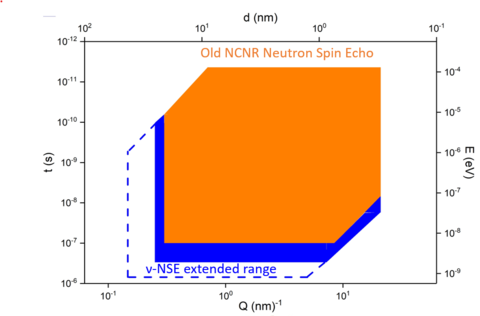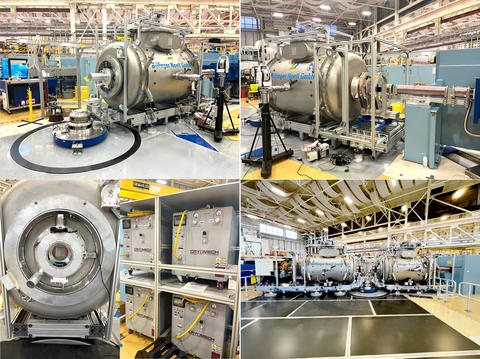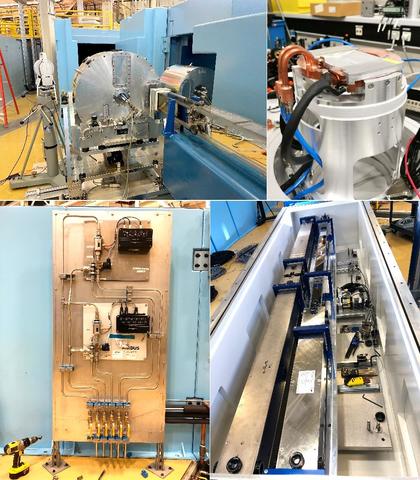NSF: A new Neutron Spin Echo Spectrometer on NG-A

A new neutron spin echo instrument, ν-NSE, has been constructed at NIST in collaboration with the University of Delaware’s Center for Neutron Science, led by Prof. Norm Wagner. It is funded by the Mid-scale Research Infrastructure program, one of NSF’s 10 Big Ideas. The instrument is essentially a replica of the new J-NSE Phoenix instrument built by JCNS and located at the MLZ in Garching, Germany.
The new instrument employs optimally designed superconducting precession coils (OSCPCs), increasing the maximum Fourier time by 2.5x. This enables the use of shorter wavelengths with significantly higher intensities for a given time window and thus increases the data acquisition rate by roughly an order of magnitude. Combining the new design with several instrument elements optimized for long wavelength operation, we expect to achieve a Fourier time of 300 ns routinely, possibly reaching 700 ns for strongly scattering samples. The extended accessible time scale will expand the opportunities to study various material systems, especially in soft matter.

Figure 1. The old NSE capable time and space domain is presented in orange, while the extended area shown in blue results from the upgrade project, with a possibility of reaching further to the dashed area for strongly scattered samples.
The OSCPCs arrived at NCNR in early Nov 2022 and passed inspection and site-acceptance tests. These tests ensured that the superconductor coils work correctly below the superconducting transition temperature of about 9K. Installation of the cryo-compressors and warm zone components for both OSCPCs was completed in early July 2023, followed by successful leak tests which involved circulating water through the correction coils. In August 2023, the instrument was in its final location at NG-A. The epoxy floor was completed in early December 2023, allowing the second arm of the spectrometer to swing up to its maximum scattering angle of 95°.

Figure 2. Construction image showing the primary optimized superconducting precession coil (OSCPC) sitting on its stationary carriage is at the final spot. The Pythagoras coil (bottom left) is one of the correction elements of the warm zone inside the OSCPC. Each superconducting coil is cooled by two large cryocoolers (bottom middle). The sample stage was installed on an epoxy floor, while aluminum panels were added on top of the epoxy floor for the secondary precession coil, analyzer, and detector (bottom right) since they are subject to swing up to 95 degrees of angle during operation.
Along with OSCPCs, several other critical components were fabricated, passed factory and site-acceptance tests, and were delivered to NCNR. These components include a neutron velocity selector (NVS) and its exchange table, a polarizer and its exchange table, an updated position-sensitive detector (PSD), warm zone components including Pythagoras coils and other correction coils mounted inside OSCPCs, new support structures, and an updated power supply system. While the new NVS and the single-V cavity polarizer are designed to work effectively with long neutron wavelengths, the old NVS and the double-V cavity polarizer will still be in use for shorter neutron wavelength applications. The new 3He PSD consists of an array of tube detectors with improved maximum count rate and sensitivity over long neutron wavelengths.

Figure 3. The top left picture shows two neutron velocity selectors (NVSs) sitting on a newly fabricated exchange table, and their control panel is at the bottom left. The old NVS (smaller one) will be reused for short wavelengths, while the new NVS (bigger one) is designed for longer wavelengths. The top right picture is the state-of-the-art Pythagoras correction coil shown in Fig. 2 when mounted inside OSCPC. The bottom right is an exchangeable polarizer station, which hosts double-V (reused) and single-V cavity (new) polarizers for short and long wavelengths.
Apart from the mezzanine for the sample area, which was delivered in April 2025 and is scheduled for installation, the new NSE instrument is now complete and ready for hot commissioning later in 2025.
On September 18-21, 2023, we successfully organized the 2nd NSE workshop at the NIST Center for Neutron Research as part of our community outreach for the NSE upgrade project. The Neutron Scattering Society of America (NSSA) sponsored three applicants selected by the organizers for their travel. The NSF fully covered all expenses for other participants. All lectures and tutorials were video-recorded, and most were published on our 2023 NSE Workshop website for public access.
At the 2024 American Conference of Neutron Scattering (ACNS) in Knoxville, TN, NCNR and ORNL scientists presented a neutron spectroscopy tutorial titled “High-Resolution Methods for Soft Matter Dynamic Investigation.”

